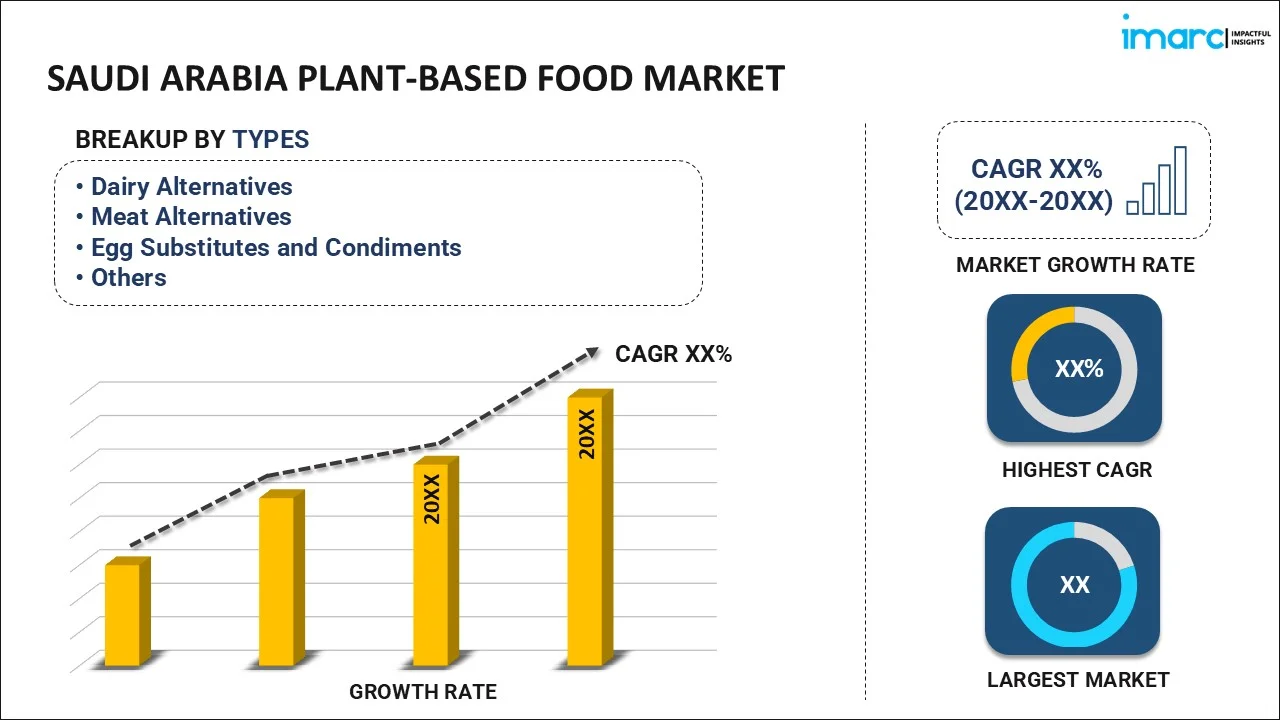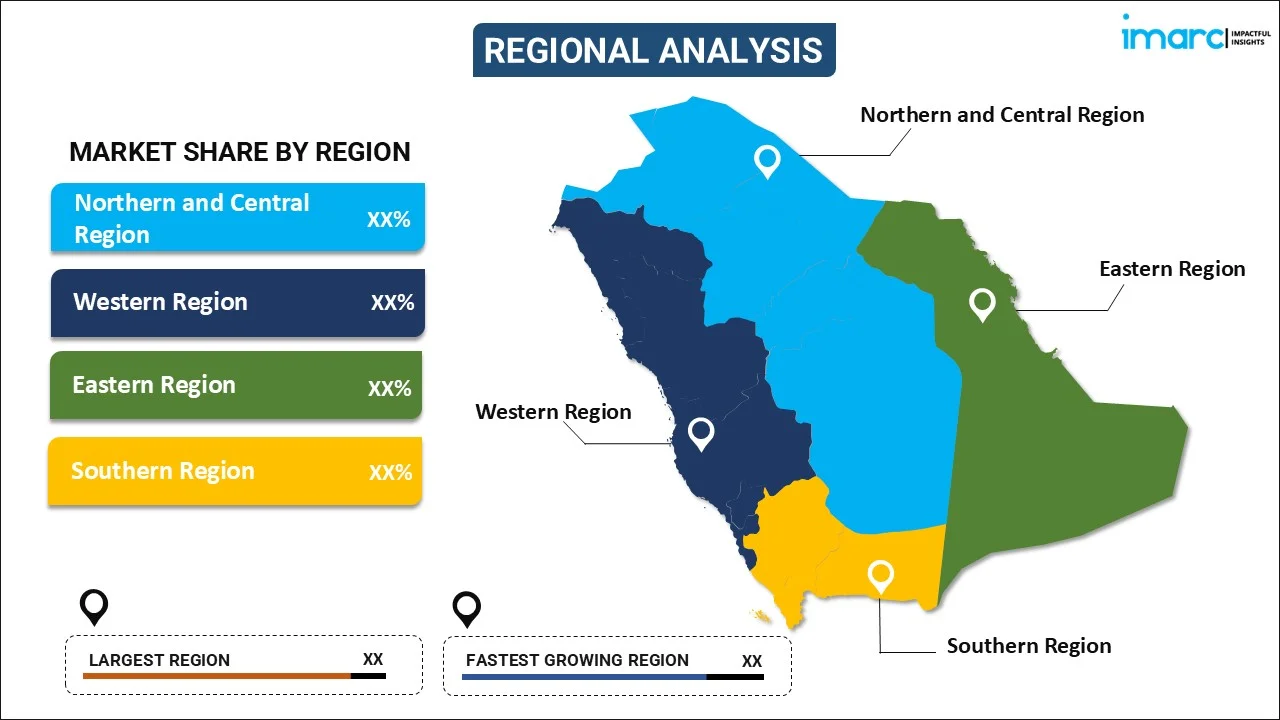
Saudi Arabia Plant-Based Food Market Size, Share, Trends and Forecast by Type, Source, Distribution Channel, and Region, 2025-2033
Saudi Arabia Plant-Based Food Market Overview:
The Saudi Arabia plant-based food market size reached USD 0.11 Billion in 2024. Looking forward, IMARC Group expects the market to reach USD 0.29 Billion by 2033 exhibiting a growth rate (CAGR) of 11.28% during 2025-2033. The market is experiencing a significant growth due to the increasing emphasis on health and wellness, population expansion, supportive government policies, a diverse selection of available food products, and rising concerns about the environment.
|
Report Attribute
|
Key Statistics
|
|---|---|
|
Base Year
|
2024 |
|
Forecast Years
|
2025-2033
|
|
Historical Years
|
2019-2024
|
| Market Size in 2024 | USD 0.11 Billion |
| Market Forecast in 2033 | USD 0.29 Billion |
| Market Growth Rate (2025-2033) | 11.28% |
Saudi Arabia Plant-Based Food Market Trends:
Population Growth
As per the Worldometer, the population of Saudi Arabia was 33,264,292 in 2023. The population of Saudi Arabia is increasing at a fast rate especially in cities. There is a rise in the demand on food supply chains to offer adequate, healthy and affordable choices to consumers. Individuals nowadays are focusing on lifestyle decisions that enhance long-term health thus creating demand for innovative and health-focused food products. This trend is driving the Saudi Arabia plant-based food market share, as consumers seek sustainable, nutritious, and ethically sourced alternatives to traditional animal-based products. People with hectic lifestyles are increasingly buying plant-based foods in the form of ready-to-eat meals, meat alternatives and milk substitutes. In addition to this, population expansion puts additional pressure on food resources compelling the demand for more sustainable foods. Plant-based foods tend to be more resource-friendly using less water, land and energy compared to conventional livestock farming. The transition to plant-based food products would also assist in the development of a more sustainable and adaptable food system to support the increasing population of the country.
Rising Focus on Health and Wellness
Growing awareness among the population of the health advantage of plant-based diets is driving Saudi Arbia plan-based food market growth. Plant-based diets have been related to reduced risk of chronic diseases like heart disease, obesity and type 2 diabetes. Plant-based diets tend to be high in fiber, antioxidants, vitamins and low saturated fats, which reduce blood pressure, regulate cholesterol and enhance blood sugar management. This emerging consciousness is making consumers opt for plant-based food products as a preemptive measure for long-term health. Furthermore, health-oriented individuals are opting for natural ingredients, whole foods and nutrient-dense products. Besides this, the benefits of plant-based diets are being positive advocated by dietitians, nutritionists and health advocates. Their observations on how plant-based food items enhance digestion help in weight control and boost energy are resonating particularly with the younger Saudi population. Due to this, the perception of the public is shifting, and plant-based food items are not only becoming accessible but also desirable for health purposes. The IMARC Group's research report projects that the Saudi Arabian health and wellness market will exhibit a CAGR of 10.08% from 2024 to 2032. These trends collectively are creating a positive Saudi Arabia plant-based food market outlook.
Saudi Arabia Plant-Based Food Market Segmentation:
IMARC Group provides an analysis of the key trends in each segment of the market, along with forecasts at the regional level for 2025-2033. Our report has categorized the market based on type, source, and distribution channel.
Type Insights:

- Dairy Alternatives
- Meat Alternatives
- Egg Substitutes and Condiments
- Others
The report has provided a detailed breakup and analysis of the market based on the type. This includes dairy alternatives, meat alternatives, egg substitutes and condiments and others.
Source Insights:
- Soy
- Almond
- Wheat
- Others
A detailed breakup and analysis of the market based on the source have also been provided in the report. This includes soy, almond, wheat and others.
Distribution Channel Insights:
- Supermarkets and Hypermarkets
- Convenience Stores
- Online Stores
- Others
A detailed breakup and analysis of the market based on the distribution channel have also been provided in the report. This includes supermarkets and hypermarkets, convenience stores, online stores and others.
Regional Insights:

- Northern and Central Region
- Western Region
- Eastern Region
- Southern Region
The report has also provided a comprehensive analysis of all the major regional markets, which include Northern and Central Region, Western Region, Eastern Regio and Southern Region.
Competitive Landscape:
The market research report has also provided a comprehensive analysis of the competitive landscape. Competitive analysis such as market structure, key player positioning, top winning strategies, competitive dashboard, and company evaluation quadrant has been covered in the report. Also, detailed profiles of all major companies have been provided.
Saudi Arabia Plant-Based Food Market News:
- On July 26, 2023, the Saudi Ministry of Environment, Water and Agriculture entered into two agreements aimed at converting agricultural plant products into plant-based food items with flavors resembling animal protein. The objective is to encourage a healthy eating culture within communities while offering high-quality vegetarian options made locally.
- On June 20, 2023, IFFCO Group launched its first completely plant-based meat product, "THRYVETV," in the Saudi market. THRYVET is recognized as the leading provider of nourishing, sustainable, and healthy local plant-based meat options, drawing inspiration from the distinctive flavors of Middle Eastern cuisine.
Saudi Arabia Plant-Based Food Market Report Coverage:
| Report Features | Details |
|---|---|
| Base Year of the Analysis | 2024 |
| Historical Period | 2019-2024 |
| Forecast Period | 2025-2033 |
| Units | Billion USD |
| Scope of the Report |
Exploration of Historical Trends and Market Outlook, Industry Catalysts and Challenges, Segment-Wise Historical and Future Market Assessment:
|
| Types Covered | Dairy Alternatives, Meat Alternatives, Egg Substitutes and Condiments, Others |
| Sources Covered | Soy, Almond, Wheat, Others |
| Distribution Channels Covered | Supermarkets and Hypermarkets, Convenience Stores, Online Stores, Others |
| Regions Covered | Northern and Central Region, Western Region, Eastern Region, Southern Region |
| Customization Scope | 10% Free Customization |
| Post-Sale Analyst Support | 10-12 Weeks |
| Delivery Format | PDF and Excel through Email (We can also provide the editable version of the report in PPT/Word format on special request) |
Key Questions Answered in This Report:
- How has the Saudi Arabia plant-based food market performed so far and how will it perform in the coming years?
- What is the breakup of the Saudi Arabia plant-based food market on the basis of type?
- What is the breakup of the Saudi Arabia plant-based food market on the basis of source?
- What is the breakup of the Saudi Arabia plant-based food market on the basis of distribution channel?
- What is the breakup of the Saudi Arabia plant-based food market on the basis of region?
- What are the various stages in the value chain of the Saudi Arabia plant-based food market?
- What are the key driving factors and challenges in the Saudi Arabia plant-based food market?
- What is the structure of the Saudi Arabia plant-based food market and who are the key players?
- What is the degree of competition in the Saudi Arabia plant-based food market?
Key Benefits for Stakeholders:
- IMARC’s industry report offers a comprehensive quantitative analysis of various market segments, historical and current market trends, market forecasts, and dynamics of the Saudi Arabia plant-based food market from 2019-2033.
- The research report provides the latest information on the market drivers, challenges, and opportunities in the Saudi Arabia plant-based food market.
- Porter's five forces analysis assist stakeholders in assessing the impact of new entrants, competitive rivalry, supplier power, buyer power, and the threat of substitution. It helps stakeholders to analyze the level of competition within the Saudi Arabia plant-based food industry and its attractiveness.
- Competitive landscape allows stakeholders to understand their competitive environment and provides an insight into the current positions of key players in the market.
Need more help?
- Speak to our experienced analysts for insights on the current market scenarios.
- Include additional segments and countries to customize the report as per your requirement.
- Gain an unparalleled competitive advantage in your domain by understanding how to utilize the report and positively impacting your operations and revenue.
- For further assistance, please connect with our analysts.
 Request Customization
Request Customization
 Speak to an Analyst
Speak to an Analyst
 Request Brochure
Request Brochure
 Inquire Before Buying
Inquire Before Buying




.webp)




.webp)












